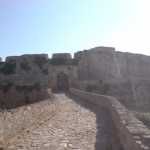Archeological treasure

Pylos, historically also known under its Italian name Navarino, has a long history, being inhabited since Neolithic times. It was a significant kingdom in Mycenean Greece, with remains of the so-called “Palace of Nestor” excavated nearby, named after Nestor, the king of Pylos in Homer’s Iliad. In Classical times, the site was uninhabited, but became the site of the Battle of Pylos in 425 BC, during the Peloponnesian War.
Methoni is a village and a former municipality in Messenia, Peloponnese, Greece. Its name may be derived from Mothona, a mythical rock. It is located 11 km south of Pylos and 11 km west of Foinikounta. Methoni has been identified as the city Pedasus, that Homer mentions under the name “ampeloessa” (of vine leaves), as the last of the seven “evnaiomena ptoliethra”, that Agamemnon offers Achilles in order to subdue his rage. Pausanias knew the city as Mothone, named after either the daughter of Oeneus or after the rock Mothon, which protects the harbour.[3] The Oinoussai complex of islands protected the port of Methoni and at the same time stopped the large sea turbulence. During the 4th century BC, Methoni was elaborately fortified and continued to remain autonomous well into the Imperial Roman era, when it enjoyed the favor of some emperors. During the Byzantine years it continued to remain a remarkable harbor and one of the most important cities of the Peloponnese, seat of a bishopric.
Koroni is nestled on a hill below an impressive Venetian castle and reaches to the edge of the gulf. The town was founded in ancient times. The Greek geographer Pausanias in his book “Messiniaka” reports the original location of Koroni at today’s Petalidi, a town a few kilometers north of Koroni. He also reports many temples of Greek gods and a copper statue of Zeus. Because of reorderings, in the centuries that followed the town of Koroni moved to its current location where the ancient town of Asini had once stood. In the 6th and 7th centuries AD, the Byzantines built a fortress there.
Most of the area of Ancient Messene contains the ruins of the large classical city-state of Messene refounded by Epaminondas in 369 BC, after the battle of Leuctra and the first Theban invasion of the Peloponnese. Epaminondas invited the return to their native land of all the families that had gone into exile from Messenia during its long struggle with and servitude under the military state of Sparta, now finished as a conquering state. This new Messene, today’s Ancient Messene, was constructed over the ruins of Ithome, an ancient city originally of Achaean Greeks, destroyed previously by the Spartans and abandoned for some time. Currently the substantial ruins are a major historical attraction. Much of it has been archaeologically excavated and partly restored or preserved for study and public viewing, as well as for various events. The site was never totally abandoned. The small village of Mavromati occupies what was the upper city around the fountain called klepsydra. Administrative structure and population figures refer primarily to it.

































